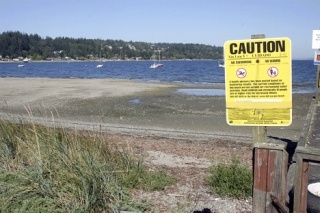FREELAND — The surge to clean up Holmes Harbor appears to be working. You still can’t eat the shellfish, but you can swim again, county health officials say.
“It’s a milestone,” Chris Wilson, assistant director of Island County Planning and Community Development, said Wednesday. “Maybe we’re halfway there.”
The beach at Freeland County Park was opened to swimmers Wednesday after the latest review of bacteria, said Dr. Roger Case, Island County health officer.
He said bacterial levels are “now quite low and pose no threat to the public’s safety.” Case said the health department will continue to monitor the area.
But a ban on shellfish harvesting imposed by state health officials remains in effect, and the red warning signs will stay up, said Jan Smith, of the South Holmes Harbor Shellfish Protection District.
Holmes Harbor has been closed for shellfish harvesting and certain recreational activities since March 2006 by order of the state health department. Preliminary results from
18 months of sampling surface water indicated the presence of fecal coliform bacteria.
Wilson said the resumption of swimming shows that a concerted community effort to battle the bacteria is paying off.
“I’m just tickled,” he said. “This is a big step. It shows we’re all working together to make progress. It’s not just one person, or one agency. It’s everybody.”
Smith agreed.
“It’s significant news,” she said. “That’s a very popular beach, and people have been frustrated.”
The shellfish protection district was formed after the ban, and it continues to monitor 18 sites around the harbor, Smith said.
The shellfish closure will remain until sufficient testing has been completed, Smith said, adding that samples can be taken only when runoff conditions are right.
“We’ve been sampling since September of 2006, and have a good baseline,” she said. “There have to be scientific methods. You can’t just go out there when it’s raining.”
“That’s the problem with science, it takes time,” Smith added. “We’re diligently tracking it.”
Wilson attributes Wednesday’s positive swimming development to an all-out effort to educate the community, and the community’s wholehearted response.
He said septic systems, pet waste, agricultural issues, business and residential practices and a number of other factors all contribute to water runoff that pollutes the harbor, and that the community has rallied.
“If fresh water isn’t clean, the marine water won’t be clean,” he said. “People have come to understand that.”
Smith agreed, saying, for example, that the first of a series of free homeowner septic training classes conducted by her agency “had a great turnout.”
Monday’s class was specifically for residents of the shellfish protection district, “and it was very positive,” she said.
Smith said the next session is today, and it’s fully booked.
Several other classes are scheduled through the end of the year, with more to come in 2009.
Wilson said local officials won’t let up until the state shellfish ban is removed and the harbor is declared clean and safe.
“We want that prohibition lifted,” he said. “This isn’t a short-term issue.”
“We don’t want to end up fixing it for now and walking away,” Wilson added. “We’re going to be there in perpetuity. We’ll always be looking at that watershed.”
“The community wants things to improve,” Wilson said. “They’re doing what it takes to improve water quality. They’re obviously buying into that effort.”
To find out more about the septic classes, call 321-5111 ext. 6069, or visit www.islandcounty.net/planning/holmesharbor.htm.
Roy Jacobson can be reached at 221-5300 or rjacobson@southwhidbeyrecord.com.



